
News
Zoom amid the gloom
At first glance, the effects of the global financial slowdown were difficult to see at the 2009 Dubai Air Show.
January 19, 2010 By Peter Pigott
At first glance, the effects of the global financial slowdown were difficult to see at the 2009 Dubai Air Show. Larger than the Farnborough International Air Show and catching up with Paris, the biennial air show, which ran from Nov. 15 to 19 and featured 890 exhibitors from 47 countries, is in its 11th year in the United Arab Emirates. Despite the current economic woes in aviation, on the final day, the show’s on-site order book topped a credible US$14 billion. But within the hospitality chalets and the hotel parties (the only places where alcohol was served) the message was the same: aerospace executives are looking to the Gulf to ease them out of recession once the economy recovers. Said one aviation analyst, “It is the one civil and military aerospace market that is holding up, driven by passenger traffic, oil prices and regional tension.”
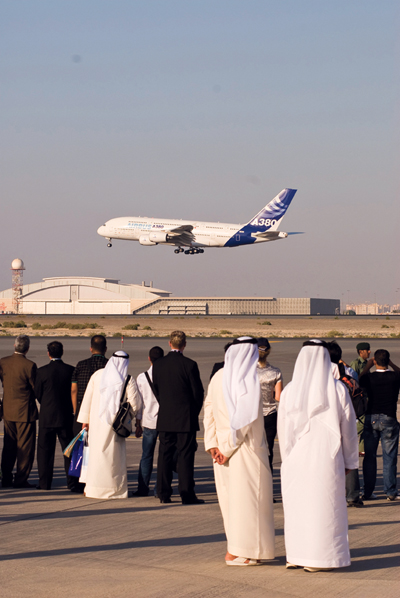 |
|
| With Emirates operating the A380 between Dubai and Toronto, the giant airliner took centre stage.
|
“Many smaller companies have opted not to participate this year, and some others that came reduced the size of their display booths or are renting fewer places,” lamented Alison Weller of F&E Aerospace, the show’s organizer. “The past year has been a difficult time for the aerospace industry worldwide.” Sheikh Ahmed Bin Saeed Al Maktoum, president of the Dubai Department of Civil Aviation, hoped that the Dubai Air Show would prime the pump of the aviation industry worldwide. “The air show comes at an important time for the aerospace industry as the world begins to see a revival in fortunes,” he said. “During the past two years, the business has experienced unprecedented turbulence.”
An observer viewing the array of aircraft outside the exhibition halls would have been hard-pressed to think that the aviation industry had been in free fall. National aerobatic teams like the “Patrouille De France” and the “Frecce Tricolori” of Italy tried to outdo each other in manoeuvres and smoke. The banners of most of the aviation world – Dassault, Boeing, Gulfstream, Sikorsky and Finmeccania – graced the hospitality chalets on the flight line. Bombardier had its Learjet 60 XR Signature Series Red aircraft, Challenger 605 jet, Challenger 850 aircraft and ultra-long-range Global Express XRS jet on display. With Emirates operating the A380 between Dubai and Toronto, the giant airliner had centre stage, dwarfing even the cavernous Russian Il-76D freighters – no mean feat.
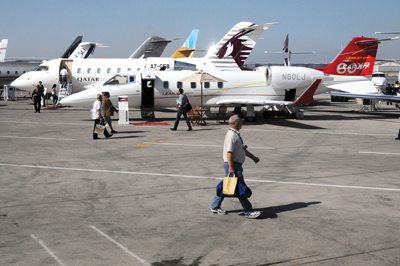 |
|
| Bombardier’s Learjet 60 XR Signature Series Red aircraft was on display along with its Challenger 605, Challenger 850 and ultra-long-range Global Express XRS. |
Demonstrating the importance of military sales, a French air force Rafale and Royal Air Force Typhoon performed daily overhead, as did a sinister-looking EADS Tiger gun ship. Surprisingly, the United States brought in a squadron of the world’s most advanced fighter, the Lockheed Martin F-22 Raptor, something it had denied the Paris air show. Several Middle Eastern air forces are in the process of replacing their fighter aircraft and such an exuberant display of American air power not only promoted U.S. interests in the Gulf region but might also have convinced Arab governments not to buy from rival Dassault. But there was no mistaking Washington’s intent at the air show. “This is a gathering of nations from this region and the world that come together to look at airplanes, talk about airpower and to gel some of their decision-making,” said Lt. Gen. Mike Hostage, the commander of U.S. Air Forces Central Command. “I had a chance to meet my counterparts in the gulf, air chiefs and ministers of defence and answer questions about U.S. airpower.”
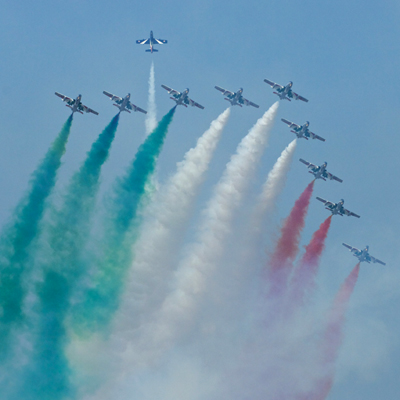 |
|
| National aerobatic teams “Patrouille De France” and the “Frecce Tricolori” performed at the show.
|
Although the United States, the European Union and Russia dominated the four exhibition halls, the display booths of China, India, Pakistan, Jordan and Canada held their own. It was the second time at Dubai for the Canadian Commercial Corporation (CCC), the government of Canada’s international contracting and procurement agency, which shared the Canadian pavilion with the Department of National Defence’s (DND) International Flight Training Group. Tom DeWolf, acting vice-president, Defence, thought the event beneficial on a number of levels. An increasing number of Canadian firms had exhibited and attended, many of whom were CCC clients looking for new business in a strategically important region. “It was valuable to network with them and with their potential sales prospects,” explained DeWolf. “Defence procurement in the region is obviously still very strong,” DeWolf said, “as evidenced by the increasingly bigger event and by the specific opportunities identified for further development.” The Department of Foreign Affairs and International Trade (DFAIT) was also very much in evidence, as the event gave CCC the opportunity to meet with the new Canadian ambassador to the United Arab Emirates, Ken Lewis and the new consul general in Dubai, Kris Panday.
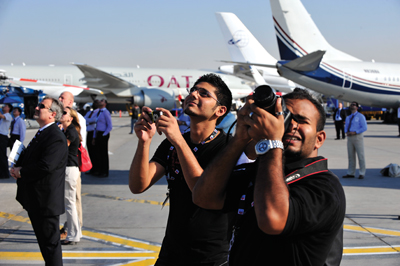 |
|
| For first-time exhibitors from Canada, the testing of the waters at the show and the marketplace proved indispensable.
|
It was Bombardier’s first time at the Dubai Air Show. “It is a good opportunity to display aircraft from our three product families: Learjet, Challenger and Global,” said Annie Cossette, Bombardier media relations. “Traditionally, the Middle East is a strong market for ultra-long-range aircraft such as the Global Express XRS, but there is growing interest for smaller aircraft such as our Learjet and Challenger jets. There is a strong demand for business aircraft from Saudi Arabia and UAE, but also a growing one from Egypt, Jordan and Lebanon.” As the Middle East was a key market for Bombardier and so many Bombardier aircraft are now based in the area, the company announced the expansion of its Mobile Response Team (MRT) into the region at the show. Bombardier has a policy of not revealing orders but Cossette did say that the Dubai Air Show had been a success and it had been a good opportunity to start dialogues with potential customers.
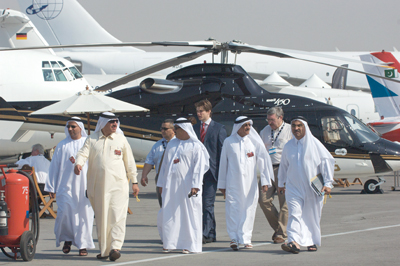 |
|
| Despite the current economic woes in aviation, on the final day, the show’s on-site order book topped a credible US$14 billion.
|
The largest Canadian presence in Dubai, and the whole Middle East, CAE was permanently based there. Begun in St. Hubert, Que., in 1947, and now a world leader in simulation, CAE ‘s annual revenues exceed $1.6 billion, with the Canadian company employing more than 6,500 people in 20 countries. The enthusiastic Chris Stellwag, CAE marketing communications director, offered a tour of the CAE-Emirates Flight Training Center (EFTC) near the airport. Jointly operated with the Emirates Group and CAE, it trains airlines and business jet operators in the Middle East, Europe, Africa, and Asia. The 14-bay centre currently houses 11 full-flight simulators: two Airbus A320/ACJs, an Airbus A330/340, a Boeing 777, two Boeing 737 NG/BBJs, a Gulfstream IV, a Gulfstream V/550, a Hawker 800/800XP, a Hawker 800XPi (Pro Line 21), and a Bell 412 helicopter simulator. At the Dubai Air Show, EFTC announced the signing of contracts with Jet Aviation, MSC Aviation, and Transaero for pilot training at the Dubai centre for Boeing, Gulfstream, and Hawker aircraft platforms.
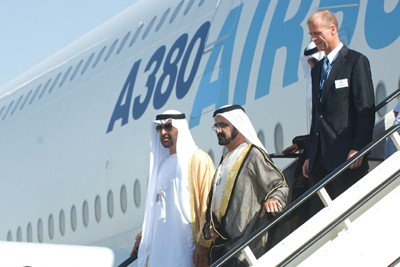 |
|
| The Dubai air show is in its 11th year in the United Arab Emirates.
|
For first-time exhibitors from Canada, the testing of the waters at the show and the marketplace proved indispensable. “It was our first time at the show,” explained Josef Azam, sales director for Montreal-based Silentium, “and we were trying to get a sense of the market and what the potential opportunities might be in the Middle East. Overall, the show was good and we made some strong new relationships.”
The very affable president of Skyplan, Adrian Bone, also said that this was his company’s first time exhibiting. Skyplan specializes in outsourced dispatch, flight planning, international trip support and fuel, and although there were numerous service providers in the area, Bone said that there was no distinct dispatch service in the Middle East. “Skyplan opened Skyplan FZC in Sharjah in November 2008, modelled after our Calgary facility. Our proprietary flight planning software, ‘CyberTrac One,’ can be accessed globally via the Internet or established via a licensing agreement for on-site use.”
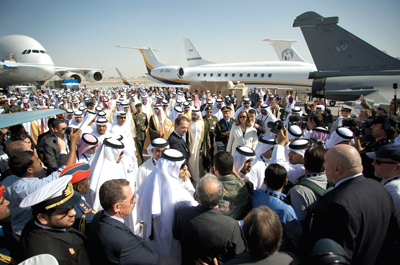 |
|
| The biennial air show featured 890 exhibitors from 47 countries.
|
Had the air show been useful? “The show itself has provided numerous new prospects for our company in both the corporate aviation arena and with the local airlines” he said. “We currently provide flight planning support to Arianna Airlines in Afghanistan, support services to Kingfisher Airlines of India and flight planning for many of the service providers in the area.” Tom Brown, Skyplan’s senior sales manager, added, “We go to four air shows in the U.S. and we have done more business in one day here than we do at a full show there. Really, it has been beyond our expectations and has been outrageously fantastic for a new guy on the block.” Skyplan was currently in the planning stages of opening a representative office in Dubai to address the local market.
Highland Integrated Surveillance Systems (HISS) is a Canadian company with offices in Portland, Ore., and the UAE. It specializes in the design, integration, installation and support of military and paramilitary airborne surveillance mission systems. Although HISS has been participating in the Dubai Air Show since 2005, this was the first time they were part of the Canada Showcase exhibit. “Approximately 80 per cent of the company revenue stems from activities performed in the Middle East,” said Mark Pickering, vice-president, Operations. “So the Dubai Air Show, like the larger biannual IDEX show, offers unique opportunities to meet with many regional defence, aerospace, and other government agency representatives.” Several valuable new relationships were cemented, he added. Potential new business opportunities were identified and discussed, and meetings with key customers and vendors were held. “The Dubai Air Show offers significant opportunities for small companies like HISS,” said company president Roger Smibert. “Relationships are key to success here, and we are proud to be a Canadian company in such an exciting and demanding region, where the need is so great and our expertise so appreciated.”
On the other hand, Esterline CMC Electronics has participated in the Dubai Air Show for many years. It was announced at the Air Show that the Ottawa-based company has been selected by the Chilean air force for the complete cockpit avionics systems upgrade of its C-130 fleet. As prime contractor, it will be responsible for delivery of the complete equipment suite, including the supply of turnkey installation kits as well as all in-country activities, including touch labour, training and support. “We are very honoured to work with the Chilean Air Force on this comprehensive modernization program,” said Greg Yeldon, president, Esterline CMC Electronics. He added, “Our Cockpit 9000 suite has been engineered using the most advanced and state-of-the-art components available today.” The Chilean Air Force’s General Rojas said, “We have been very impressed with CMC’s flexibility in adapting its Cockpit 9000 to our specific needs while being able to schedule a very rapid installation turnaround.”
The last day of the show was eclipsed by Dubai’s own financial problems that mirror aviation’s: for all the glitz and firepower in evidence, the recession is still very evident. F&E Aerospace, the air show’s organizers, hoped that maybe by the next show to be held in 2011, the problems will have ended. Amen to that.